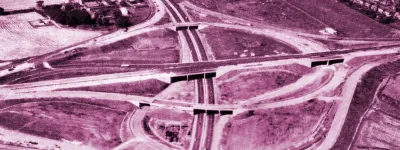The A500 is a very strange road. It's an urban access road for Stoke-on-Trent which continues north-westward to serve Crewe. What really makes it distinctive, though, is that it's such a clever idea.
In a rare and alarming outbreak of joined-up planning, the important M6 is spared the trouble (suffered when passing through the populous areas near Birmingham and Manchester) of multiple local access points. Instead, it has from the outset taken a decorous sweep past the Potteries, connecting only to the A500 at junctions 15 and 16, and otherwise clocking up the miles without being distracted.
The A500 itself does all the work in between, forming an arc around the east side of the motorway. The two of them form the shape of a capital D, and for that reason the A500 is sometimes nicknamed the Stoke "D-road".
Since 2006, it's been entirely grade-separated between its terminal roundabouts. And hurrah for that. Unlike almost any other urban area in the UK, Stoke-on-Trent has a fast arterial route zooming traffic in, out and through the city. The A50 cross-country route was plugged in to the A500 at Sideway in the late 1990s, as if to confirm that this is the backbone of the whole road network in the Potteries.
Stoke-on-Trent is, of course, no ordinary city. It's not really a city at all, rather a coalition of towns and villages that add up to something the size of a city but without a real central point. The railway station, lying alongside the A500, often looks a bit lost, and the nominal centre of Stoke is actually at Hanley. Motorists are advised to treat signs on the A500 for "city centre" with caution.
Since it was first created in the mid-1960s, the A500 has been extended west from junction 16 to reach Crewe more easily, and in recent years, further still to bypass Hough and Shavington. Everything west of the M6 is of a much lower standard (in fact, it's downright disappointing in comparison to the D-road) and so does not appear in the exit list or factfile here.
The number A500 is not, of course, native to these parts: its closest relative around Stoke is probably A519. It started life in central London, running from the A5 near Marble Arch towards Finchley, including what was then the spanking-new Hendon Way. The A41 requisitioned this route, freeing up the A500 number, at which point it donned its hat and coat, and went to start a new life in Staffordshire.
You're not looking at the whole A500
This page is about the parts of the A500 that are designated a motorway or that have motorway characteristics. Other sections of this road will not be featured here and will not count towards the length of the road as shown below.

